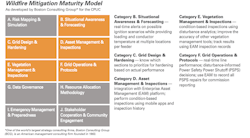Managing Wildfire Risk: The Delicate Balance of Safety and Reliability
Wildfire is one of today’s greatest threats to natural landscapes, homes, businesses, and even entire towns today. According to the National Interagency Fire Center, 45,118 wildfires consumed 5.7 million acres (about twice the area of Connecticut) in the United States during the months of Jan. — Sept. 2021. Only ten percent of wildfires are attributable to natural causes such as lightning or lava. The other 90% are caused by humans, including electrical distribution wires. Wildfire danger is exacerbated by changing climate and the spread of human development into wildlands.
The potential for the electrical distribution grid to cause — or be damaged by — wildfires is well known. Wildfire devastation is far-reaching and costly. The financial implications for electric utilities can be astronomical as well. As Columbia’s Center on Global Energy Policy explains:
“If a utility is found to have operated its system imprudently, the company could be held liable for such damages, which are likely to be in the billions of dollars...Wildfire increases costs to utility-sector stakeholders, including investor-owned utilities, state and local governments, ratepayers, and taxpayers.”
Big Problem. Big Potential.
The U.S. electrical grid is the largest interconnected machine on Earth: 200,000 miles of high-voltage transmission lines and 5.5 million miles of local distribution lines.
Traditional measures — such as visual inspection, whether it is by crews on the ground or drones, hardening measures, undergrounding, replacing grid assets, and vegetation management strategies — are not sufficient, take too much time, and are expensive. Other more extreme preventative measures, like Public Safety Power Shutoffs (PSPS), also fall short. They leave thousands of people without power for extended periods of time, often impacting more power customers than necessary. Measuring the negative impact, customer ill will, and costs of power shutoffs against the resulting wildfire risk reduction is near impossible.
Unsurprisingly, electric utilities are keenly aware of wildfire risk, realizing that there is no single solution or set of technologies that can address this complex issue. Seeking out and implementing the most effective mix of solutions will improve public safety and power reliability. And, the time has never been more critical. According to the U.S. Drought Monitor, about 90% of land in the Western states is experiencing moderate to severe drought in 2021, with no near-term improvement on the horizon.
Intelligent Sensors and Data Analytics Can Change the Risk Factors
Many utilities are investing in advanced line sensors, software, and big data analytics to improve line safety and reduce outages. Intelligent line sensors have emerged as a crucial addition to wildfire risk mitigation efforts as they offer the ability to pinpoint trouble spots through detailed monitoring of the distribution grid, capturing data that is then analyzed and used to inform and prioritize fire mitigation decisions.
According to Boston Consulting Group (BCG), analytics and big data can optimize vegetation management and delay the average trimming cycle by more than 20% without compromising grid reliability. Additionally, the BCG team, in concert with utilities in California, also include data and analytics as one of the four keys to wildfire mitigation:
“Data and analytics will enable decisions that are faster, more consistent, and more transparent, while ensuring utilities use an informed assessment of risk in the longer-term."
Intelligent line sensors provide utilities with comprehensive, real-time system visibility enabling the identification of areas needing immediate preemptive maintenance. By monitoring and detecting waveform changes, utilities can identify downed or failing distribution lines, and disturbances from vegetation, to prioritize and target vegetation control. Sensors provide visibility that helps utilities make more informed decisions based on accurate information about load levels, phase balance, interruptions, and disturbances.
Intelligent Grid Monitoring is Key to Reducing Wildfire Risk
Virtually all utilities have implemented some form of grid monitoring technology. Assessing the needs of a particular distribution grid begins with understanding and prioritizing goals. Many of our customers, including over twenty-five of the largest utilities in the North America, are assessing the need for grid intelligence and prioritizing goals to get started. Many of our customers are taking the following steps:
1. Prioritize High-Risk Areas
Adding or expanding grid monitoring is an important part of any wildfire mitigation strategy. Prioritization can be simplified by assessing areas of the grid where line disturbances indicate a likelihood of further vegetation interference and therefore, risk of ignition and wildfire. To make effective decisions, start by assessing the location and environment of the grid, existing modernization and hardening strategies, and current vegetation management and grid operations protocols. Use these criteria to create a clear risk model for each sector of the grid and prioritize the placement of intelligent sensors accordingly.
2. Name and rank objectives
Clearly define grid monitoring objectives and prioritize each one by its potential to make maximum impact. Safety and reliability are typically the first mandates, but need to be considered at a granular level, beyond top level SAIDI and SAIFI scores. Ask questions to think more granularly. For example: which specific zones are prone to heavy vegetation or high winds that create risk. Can you pinpoint specific grid components that are reaching the end of their useful life? Are there areas with little visibility and control such as in rural or remote areas?
Looking at wildfire priorities carefully will inform investments in line sensor solutions that meet the most critical objectives.
3. Define measurable target results
With objectives established, dive deeper to assign measurable targets and milestones. Define the top three to five measurable steps considering time, operational expense, and results, and prioritize the ones with the greatest potential for positive impact.
Providers of distribution grid components such as sensors, software, and analytics, can offer industry data and trends analysis that can help you scope your grid monitoring projects and set measurable goals.
4. Create a data strategy complete with experts, equipment, and software
Intelligent line sensors provide a vast amount of data that can be leveraged through analytics software and management systems for safe, efficient, and resilient grid operations. The most successful data strategies are built to support specific objectives and reveal specific insights. Categorize and prioritize data by type and use so that it can be efficiently used for critical decision-making. With the right data strategy, data can be parsed and utilized to support decisions with insights. For data to be useful, it must be purposefully generated and applied to specific questions or problems.
5. Look to proven vendors for help
Work with a trusted vendor who has proven experience in implementing intelligent line sensors and analytics solutions. Sentient Energy provides the most broadly deployed intelligent sensing solution in North America. Our solutions comprise state-of-the-art intelligent sensors, real-time data, advanced analytics, and innovative grid edge voltage control technologies.
Sentient Energy’s intelligent line sensing technology and analytics software have helped utilities quickly and cost-effectively reduce risk in five Key Assessment Categories of the Boston Consulting Group Wildfire Mitigation Maturity Model.
Intelligent sensors and analytics enable electric utilities to strengthen existing wildfire risk mitigation strategies with data for more informed decisions around condition-based line inspections, pre-emptive maintenance, more focused grid hardening efforts, and prioritized repair audits. In the case of active wildfire situations, intelligent sensors can provide real-time alerts of faults or possible ignition sources, deliver a constant data feed into Emergency Operations Centers, and trigger deployment of complementary safety equipment and teams.
Intelligent line sensors, data and analytics are a key component of wildfire risk mitigation strategies. As more data is collected and analyzed over time, serious wildfire incidents can be reduced or even avoided in the future.
About the Author
Sarah Prinster
Sarah Prinster is the senior director of marketing, Sentient Energy.


